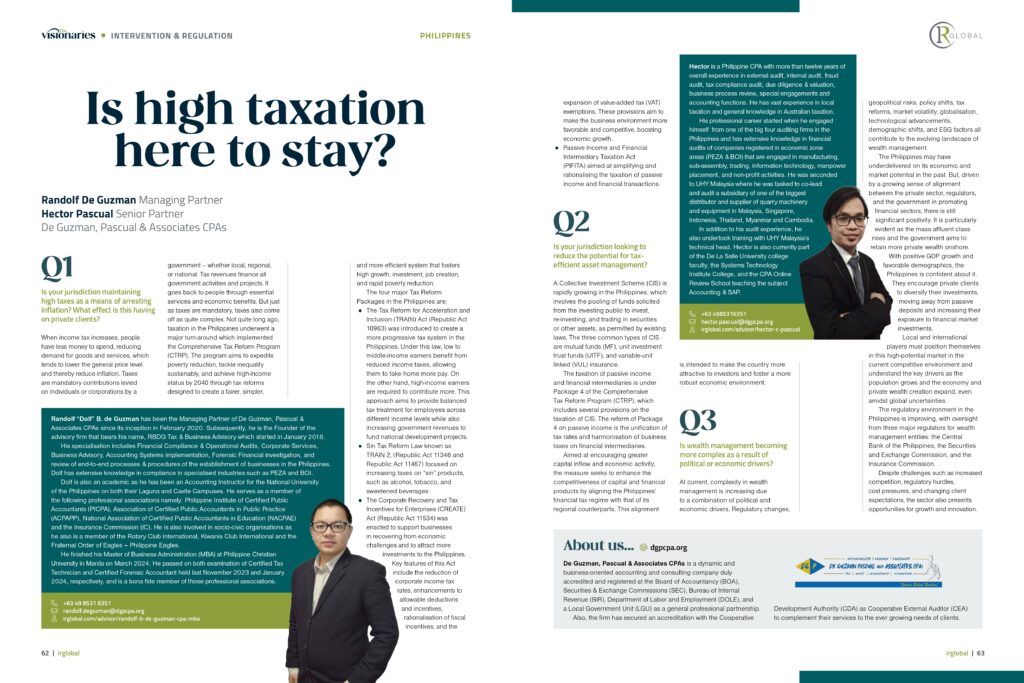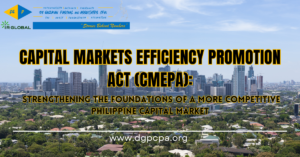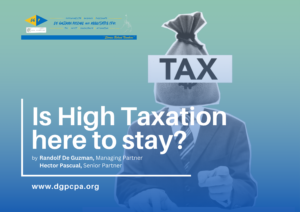Q1
Is your jurisdiction maintaining high taxes as a means of arresting inflation? What effect is this having on private clients?
When income tax increases, people have less money to spend, reducing demand for goods and services. This tends to lower the general price level and thereby reduce inflation. Taxes are mandatory contributions levied on individuals or corporations by a government—whether local, regional, or national. Tax revenues finance all government activities and projects, which return to people through essential services and economic benefits. However, while taxes are mandatory, they can also be quite complex.
Not long ago, taxation in the Philippines underwent a major turnaround with the implementation of the Comprehensive Tax Reform Program (CTRP). This program aims to expedite poverty reduction, tackle inequality sustainably, and achieve high-income status by 2040 through tax reforms designed to create a fairer, simpler, and more efficient system that fosters high growth, investment, job creation, and rapid poverty reduction.
The four major Tax Reform Packages in the Philippines are:
- The Tax Reform for Acceleration and Inclusion (TRAIN) Act (Republic Act 10963)
This act was introduced to create a more progressive tax system in the Philippines. Under this law, low to middle-income earners benefit from reduced income taxes, allowing them to take home more pay, while high-income earners are required to contribute more. This approach aims to provide balanced tax treatment for employees across different income levels while also increasing government revenues to fund national development projects. - Sin Tax Reform Law (TRAIN 2) (Republic Act 11346 and Republic Act 11467)
This law focuses on increasing taxes on “sin” products, such as alcohol, tobacco, and sweetened beverages. - The Corporate Recovery and Tax Incentives for Enterprises (CREATE) Act (Republic Act 11534)
This act was enacted to support businesses in recovering from economic challenges and to attract more investments to the Philippines. Key features include the reduction of corporate income tax rates, enhancements to allowable deductions and incentives, rationalisation of fiscal incentives, and the expansion of value-added tax (VAT) exemptions. These provisions aim to make the business environment more favorable and competitive, boosting economic growth. - Passive Income and Financial Intermediary Taxation Act (PIFITA)
This act aims at simplifying and rationalising the taxation of passive income and financial transactions.

Q2
Is your jurisdiction looking to reduce the potential for tax-efficient asset management?
A Collective Investment Scheme (CIS) is rapidly growing in the Philippines. It involves pooling funds solicited from the investing public to invest, re-invest, and trade in securities or other assets, as permitted by existing laws. The three common types of CIS are mutual funds (MF), unit investment trust funds (UITF), and variable-unit linked (VUL) insurance.
The taxation of passive income and financial intermediaries falls under Package 4 of the Comprehensive Tax Reform Program (CTRP), which includes several provisions on the taxation of CIS. The reform of Package 4 focuses on the unification of tax rates and the harmonisation of business taxes on financial intermediaries. Aimed at encouraging greater capital inflow and economic activity, this measure seeks to enhance the competitiveness of capital and financial products by aligning the Philippines’ financial tax regime with that of its regional counterparts. This alignment is intended to make the country more attractive to investors and foster a more robust economic environment.
Q3
Is wealth management becoming more complex as a result of political or economic drivers?
Currently, complexity in wealth management is increasing due to a combination of political and economic drivers. Regulatory changes, geopolitical risks, policy shifts, tax reforms, market volatility, globalisation, technological advancements, demographic shifts, and ESG factors all contribute to the evolving landscape of wealth management.
The Philippines may have underdelivered on its economic and market potential in the past. However, there is significant positivity driven by a growing sense of alignment between the private sector, regulators, and the government in promoting financial sectors. This is particularly evident as the mass affluent class rises and the government aims to retain more private wealth onshore. With positive GDP growth and favorable demographics, the Philippines is optimistic about its outlook. They encourage private clients to diversify their investments, moving away from passive deposits and increasing their exposure to financial market investments.
Local and international players must position themselves in this high-potential market and understand the key drivers as the population grows and the economy and private wealth creation expand, even amidst global uncertainties.
The regulatory environment in the Philippines is improving, with oversight from three major regulators for wealth management entities: the Central Bank of the Philippines, the Securities and Exchange Commission, and the Insurance Commission.
Despite challenges such as increased competition, regulatory hurdles, cost pressures, and changing client expectations, the sector also presents opportunities for growth and innovation.



